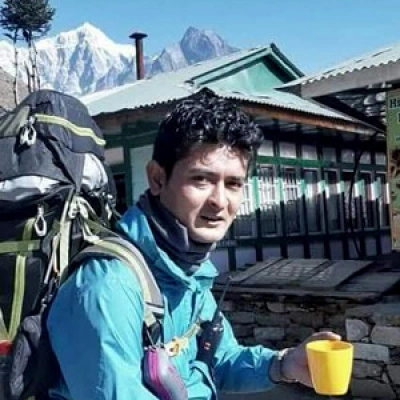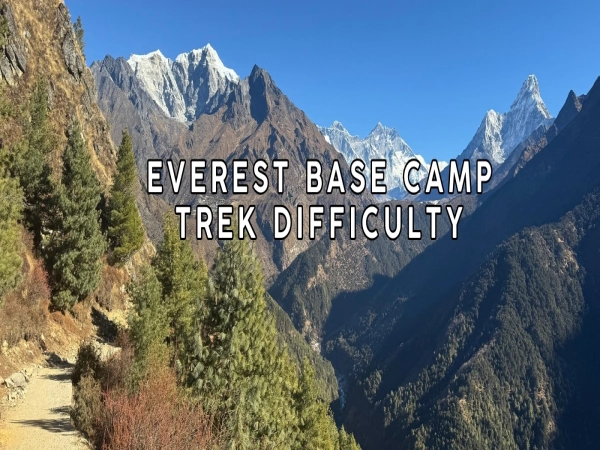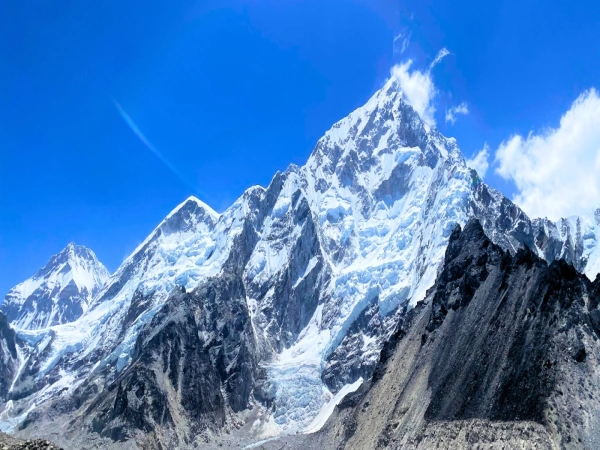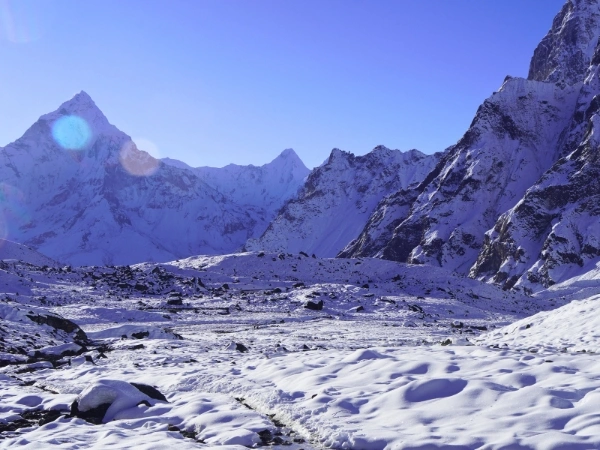Both the Lobuche East and Island Peak climb is an unlimited package of thrilling and remarkable adventures for a lifetime! The climbs have physical difficulty and technical challenges.
These are the popular climbing peaks in Nepal. They are the preparatory climb one opts for before going for the real expeditions. Both these peaks are in the Everest region. And the successful climb offers the best views of Mount Everest, Mt. Ama Dablam, Nuptse, and many others.
Island peak was the practice climb chosen by Edmund Hillary and Tenzing Norgay before their actual ascend to Mount Everest summit. This way, the climbing peak is popular.
Whereas, Lobuche peak is the extension of the Everest. It has many peaks where the Lobuche east and the Lobuche west. And, when you climb Lobuche peak its Lobuche east.
The Island peak is difficult in a different way than the hardness of the Lobuche peak. Yet, their peaks offer the adventures of their own. And, both these peaks are doable with enough technical and physical preparations. Not to forget the proper packing.
Highlights of Lobuche and Island Peak Climbing
- An excursion to Kala Patthar, the best viewpoint of Mt. Everest and the Everest Base Camp.
- You can see breathtaking views of the many Himalayas including Everest, Cho Oyu, Pumori, Lhotse, Makalu, Nuptse, Ama Dablam, and other surrounding peaks.
- Lobuche and Island Peak Climbing provides a warm and friendly Sherpa culture and traditions.
- A remarkable visit to the Khumbu region, the region of high Himalayas in Nepal.
- Interactions and good coordination with the experienced Everest summiteer, the Sherpa guides.
- The beautiful Sagarmatha National Park, a UNESCO World Heritage site.
- The age-old Sherpa culture, their warm hospitality, and the spiritual Buddhist Monasteries.
- Colorful prayer flags, indicating purity and spiritual.
The Lobuche peak vs Island peak has different topics to make a comparison. It includes the variation in geography, altitude, climbing difficulty, modes of accommodations.
Geographical Comparison
Island Peak
It is also called as Imja Tse appears as a sea of ice as seen from Dingboche. So people call it an Island peak. The famous Island peak sits above the summer settlements in Chhukung village. And, a 10 km away to the south of Mt. Everest.
In Chhumrung, the Imja river flows, it is the gateway to the actual Island Peak climb. Island peak is between Mt. Ama Dablam and Mt. Lhotse. It stands high, right above the Chukung glacier. Island peak is more popular because of its challenging geography.
Are you planning your Peak Climbing in Nepal? Don't hesitate to contact us. Tell us your requirements, we can help you to make your trip memorable.
Lobuche East Peak
The Lobuche east peak is a beautiful trekking peak in the Khumbu region. The peak is above the Lobuche Village, a beautiful Sherpa settlement. The Lobuche east peak offers different trekking routes. However, the normal climbing route is through the South Ridge.
The peak has many ridges, glaciers, and the rigorous ascends. The climb begins from the Lobuche Base Camp an ascend from the Lobuche village. The summit offers amazing views of the majestic Himalayas including Everest.
Comparison in Terms of Altitude
Both the Island Peak and the Lobuche East peak are the popular climbing peaks in the Everest Region. Both are the High altitude climbs.
Lobuche East Peak
The Lobuche east summit stands 6199 m tall. During the Lobuche East climb, you will pass across two camps. The Lobuche Base Camp, 4950 m, and the Lobuche High Camp, 5400 m. There is a small and beautiful Sherpa village towards the west, the Lobuche village, 4930 m.
Island Peak
The summit of Island peak is at an altitude of 6189 m from the sea level. During the Island peak climb, there is an Island Peak Base camp at an altitude of 5087m. There is a place named Chhukung, 4730 m, between the Lobuche East peak and the Island peak.
Both these peak climbing takes you to the altitude above 5000 meters into the sea of snow. So, there are many chances of altitude sickness and frost bites you may catch during the climbing. However, with proper acclimatization and packing lists, you can reduce the risks.
Climbing and Difficulty
Both the Island Peak and Lobuche Peak East are the most challenging and popular climbing peaks in the Khumbu region. They are the hardest ascending peaks. Lobuche peak (East) is the technical and challenging one. The Island peak is the more popular climb.
Lobuche (East) Peak
The Lobuche Peak has several small summits. But when we say Lobuche Peak climb, we mean the Lobuche East summit. The Lobuche peak climb is the most technical and challenging climb. The climb to the summit includes sharp descents. There is also a steep 45-degree climb through snowy slopes.
For the Lobuche East climb, a climber requires an advanced knowledge about climbing. Also, the skills to use the climbing gears must be perfect. You must learn the use of descender on fixed lines. Also, the use of crampon and ice axes, ice screws and pickets while fixing the ropes must be proper.
The steep, slippery and icy rock slabs are not easy to deal with. The snow slopes are the challenges. Before the climb, you must have advanced rock climbing skills.
Laurence Nielson and Sherpa Ang Gyalzen made their first ascent to the Lobuche East Peak on 24th April 1984.
Island Peak
The Island Peak, also known as Imja Tse stands gracefully in the sea of ice, wearing a beautiful snow crown when viewed from Dingboche. Sir Eric Shipton, on exploring the Barun George in 1952 caught a sight of the peak and named it as the ‘Island Peak’.
Located above the summer settlements of Chhukung, Island peak is a popular trekking peak in the Khumbu region. The island peak is a difficult climb. The climb includes several technical sections.
For the summit, you have to walk through many crevasses and rocky, slippery boulders. For this, a good skill of using ropes, ice axe, and crampons are a must. However, it is easier than the Lobuche East climb technically.
The first ascent made to the summit was by Charles Evan, Alf Gregory, Charles Wylie, and Tenzing Norgay. People choose the Island peak climb before the higher ascents including Everest itself.
Are you planning your Peak Climbing in Nepal? Don't hesitate to contact us. Tell us your requirements, we can help you to make your trip memorable.
Mode of Accommodation
The peak climbing in Nepal is always the combination of trekking and climbing. The accommodation during the treks is tea house/ lodge accommodation. But for the climbs, you leave the settlement area up in the higher altitudes. In such places from the base Camps, you have to accommodate the camps and enjoy the meals prepared by our cooks.
Island peak
During Island Peak climbing you spend your nights in ample of teahouses up to the Chhomrong village. From the village, as you leave for the Island Peak Base Camp you proceed to the sea of ice with no settlements. So, you will stay in the camps.
Lobuche East Peak
For Lobuche Peak Climbing you will get to enjoy the basic facilities for food and accommodations up to the Lobuche village. There are several teahouses and lodges at your services on the way to the village. But, as you ascend to the Lobuche Peak Base Camp you have to spend nights on the tents. And accommodate with the basic services our team provides.
Note: During your accommodation, take good care of your health and safety. Maintain your personal hygiene, cheer up and enjoy wherever you are. Be extra careful during your tent accommodation.
Physical Condition & Experience Requirements
The Island Peak and the Lobuche East climb are high altitude climbs. Climbing these peaks is strenuous. Thus, proper physical condition and a suitable acclimatization schedule are prerequisites of the climb.
Boost your willpower, enhance your flexibility! Train your mind and body to encounter every obstacles, challenges and harsh weather conditions. This is the key to your successful climbs.
The Lobuche East Peak climb requires 5-6 hours of walking per day in general. However, during the Island Peak climb, you must walk for 10- 12 hours on the summit day.
For the climbs, the previous climbing experience is not mandatory. But the previous rock climbing and high altitude trekking experiences are beneficial. The ice climbing training and experience plus the skill to tie ropes, use ice axe and crampons eases the climbs.
A person having heart, lung, and blood diseases might have more difficulties during the trek. Sometimes, choosing the climb can even be fatal to them. So, for both the climbs, consult your medical adviser before you go.
Best Time to Travel
The Spring season (March to May) and Autumn (September to November) are the best time for the climbs in Island peak and the Lobuche East Peak. The peak climbing is doable in winter too.
However, a climber may find it difficult to sustain in the freezing cold in winter. For winter climbing you must be extra careful and physically fit. Opt, for these climb in winter only if you have early climbing experiences.
Conclusion
The Lobuche East climb is more technical and challenging than Island Peak climb. But both the climbs are worth the time, money, and your effort.
The adventurous climb to the Lobuche East and Island peak displays the magnificent views of several mountains. The tranquil views of Lhotse, Makalu, Nuptse, Baruntse, Ama Dablam and other peaks are eye soothing.
To book your trip to Everest regions, or any other regions in Nepal, you can contact us. We promise to prepare you properly for such adventurous climbs like these.




